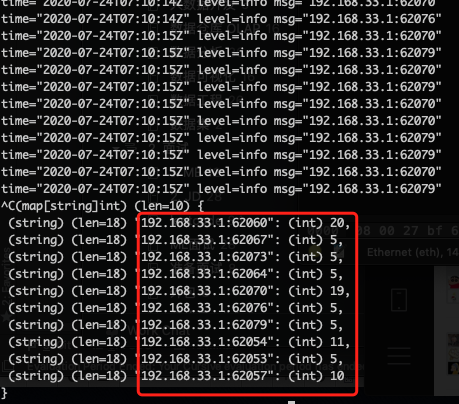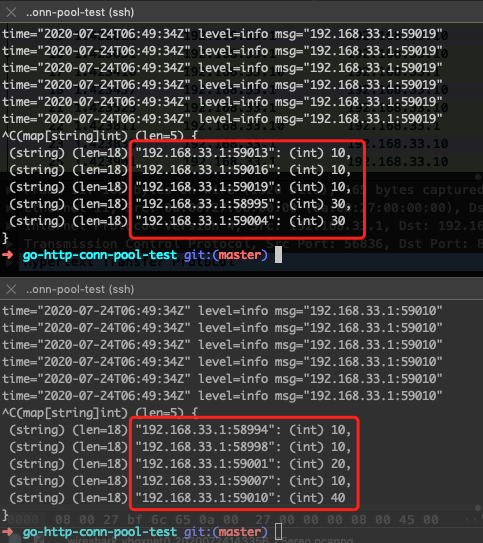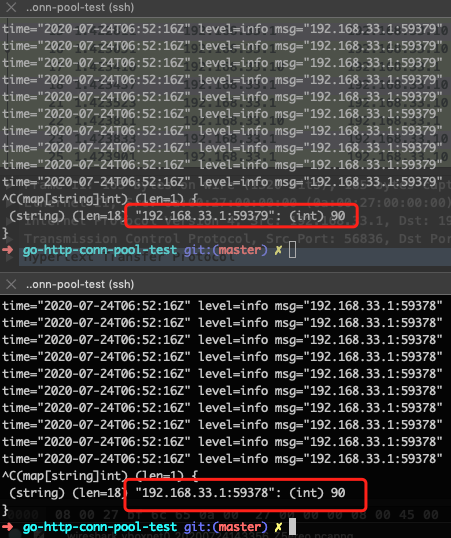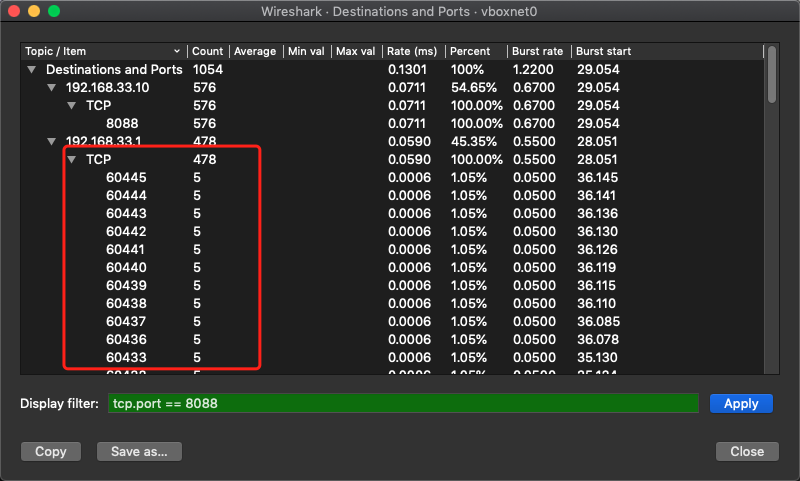

实验说明 Golang HTTP 连接池参数
source link: https://luckymrwang.github.io/2023/01/05/%E5%AE%9E%E9%AA%8C%E8%AF%B4%E6%98%8E-Golang-HTTP-%E8%BF%9E%E6%8E%A5%E6%B1%A0%E5%8F%82%E6%95%B0/
Go to the source link to view the article. You can view the picture content, updated content and better typesetting reading experience. If the link is broken, please click the button below to view the snapshot at that time.
连接相对于其他对象,创建成本较高,资源也有限。如果没有连接池,在高并发场景下,连接关闭又新建,很快就会因为过多的TIME_WAIT(连接主动关闭方)导致无法创建更多连接了,程序被压死。
net/http 连接池参数
Go (测试版本 go 1.14)的net/http包是有连接池功能的,具体地,是 Transport 用于连接池化。
Transport is an implementation of RoundTripper that supports HTTP, HTTPS, and HTTP proxies (for either HTTP or HTTPS with CONNECT).
By default, Transport caches connections for future re-use.
// MaxIdleConns controls the maximum number of idle (keep-alive)
// connections across all hosts. Zero means no limit.
MaxIdleConns int
// MaxIdleConnsPerHost, if non-zero, controls the maximum idle
// (keep-alive) connections to keep per-host. If zero,
// DefaultMaxIdleConnsPerHost is used.
MaxIdleConnsPerHost int
// MaxConnsPerHost optionally limits the total number of
// connections per host, including connections in the dialing,
// active, and idle states. On limit violation, dials will block.
//
// Zero means no limit.
MaxConnsPerHost int
// IdleConnTimeout is the maximum amount of time an idle
// (keep-alive) connection will remain idle before closing
// itself.
// Zero means no limit.
IdleConnTimeout time.Duration
MaxIdleConns=100,MaxIdleConnsPerHost=2(=DefaultMaxIdleConnsPerHost),MaxConnsPerHost=0(不限制)。
// DefaultTransport is the default implementation of Transport and is
// used by DefaultClient. It establishes network connections as needed
// and caches them for reuse by subsequent calls. It uses HTTP proxies
// as directed by the $HTTP_PROXY and $NO_PROXY (or $http_proxy and
// $no_proxy) environment variables.
var DefaultTransport RoundTripper = &Transport{
Proxy: ProxyFromEnvironment,
DialContext: (&net.Dialer{
Timeout: 30 * time.Second,
KeepAlive: 30 * time.Second,
DualStack: true,
}).DialContext,
ForceAttemptHTTP2: true,
MaxIdleConns: 100,
IdleConnTimeout: 90 * time.Second,
TLSHandshakeTimeout: 10 * time.Second,
ExpectContinueTimeout: 1 * time.Second,
}
PerHost 的 Host 是 addr+port
单台服务器,多个端口的服务是不同的 Host。
// canonicalAddr returns url.Host but always with a ":port" suffix
func canonicalAddr(url *url.URL) string {
addr := url.Hostname()
if v, err := idnaASCII(addr); err == nil {
addr = v
}
port := url.Port()
if port == "" {
port = portMap[url.Scheme]
}
return net.JoinHostPort(addr, port)
}
服务端准备工作
https://github.com/luckymrwang/go-http-conn-pool-test
# 长连接服务器 192.168.33.10:8087
go run main.go -port 8087
# 长连接服务器 192.168.33.10:8089
go run main.go -port 8089
# 短连接服务器 192.168.33.10:8088
python3 -m http.server 8088
MaxIdleConnsPerHost 控制单个Host的连接池大小
单个连接池数设置为1。设置 MaxConnsPerHost=MaxIdleConnsPerHost,保证连接都是长连接。方便抓包工具查看连接池的数量。
// 参数配置
var _httpCli = &http.Client{
Timeout: time.Duration(15) * time.Second,
Transport: &http.Transport{
MaxIdleConnsPerHost: 1,
MaxConnsPerHost: 1,
IdleConnTimeout: 90 * time.Second,
TLSHandshakeTimeout: 10 * time.Second,
ExpectContinueTimeout: 1 * time.Second,
},
}
// 测试
func TestLong(t *testing.T) {
go func() {
for i := 0; i < 1000; i++ {
go get("http://192.168.33.10:8087")
}
}()
time.Sleep(time.Second * 10)
}
image
连接复用的效果
一个连接顺序处理多个HTTP请求。Wireshark 展示。
image
MaxConnsPerHost 控制单个Host的最大连接总数
net/http包里没有全局性的连接总数限制参数。该值默认是0,也就是不限制,连接池里的连接能用就用,不能用创建新连接。无法进入连接池回收的短连接,被主动关闭。
如果不限制,直接 dialConn。如果限制,未达到限制,直接dialConn,计数+1;达到限制,进入等待队列中。
// queueForDial queues w to wait for permission to begin dialing.
// Once w receives permission to dial, it will do so in a separate goroutine.
func (t *Transport) queueForDial(w *wantConn) {
w.beforeDial()
if t.MaxConnsPerHost <= 0 {
go t.dialConnFor(w)
return
}
t.connsPerHostMu.Lock()
defer t.connsPerHostMu.Unlock()
if n := t.connsPerHost[w.key]; n < t.MaxConnsPerHost {
if t.connsPerHost == nil {
t.connsPerHost = make(map[connectMethodKey]int)
}
t.connsPerHost[w.key] = n + 1
go t.dialConnFor(w)
return
}
if t.connsPerHostWait == nil {
t.connsPerHostWait = make(map[connectMethodKey]wantConnQueue)
}
q := t.connsPerHostWait[w.key]
q.cleanFront()
q.pushBack(w)
t.connsPerHostWait[w.key] = q
}
如果计数-1,从等待队列中释放一个进行 dialConn。
// decConnsPerHost decrements the per-host connection count for key,
// which may in turn give a different waiting goroutine permission to dial.
func (t *Transport) decConnsPerHost(key connectMethodKey) {
if t.MaxConnsPerHost <= 0 {
return
}
t.connsPerHostMu.Lock()
defer t.connsPerHostMu.Unlock()
n := t.connsPerHost[key]
if n == 0 {
// Shouldn't happen, but if it does, the counting is buggy and could
// easily lead to a silent deadlock, so report the problem loudly.
panic("net/http: internal error: connCount underflow")
}
// Can we hand this count to a goroutine still waiting to dial?
// (Some goroutines on the wait list may have timed out or
// gotten a connection another way. If they're all gone,
// we don't want to kick off any spurious dial operations.)
if q := t.connsPerHostWait[key]; q.len() > 0 {
done := false
for q.len() > 0 {
w := q.popFront()
if w.waiting() {
go t.dialConnFor(w)
done = true
break
}
}
if q.len() == 0 {
delete(t.connsPerHostWait, key)
} else {
// q is a value (like a slice), so we have to store
// the updated q back into the map.
t.connsPerHostWait[key] = q
}
if done {
return
}
}
// Otherwise, decrement the recorded count.
if n--; n == 0 {
delete(t.connsPerHost, key)
} else {
t.connsPerHost[key] = n
}
}
试验:尝试连接池1,最大连接数2。
// 参数配置
var _httpCli = &http.Client{
Timeout: time.Duration(15) * time.Second,
Transport: &http.Transport{
MaxIdleConnsPerHost: 1,
MaxConnsPerHost: 2,
IdleConnTimeout: 90 * time.Second,
TLSHandshakeTimeout: 10 * time.Second,
ExpectContinueTimeout: 1 * time.Second,
},
}
// 测试
func TestLong(t *testing.T) {
go func() {
for i := 0; i < 100; i++ {
if i%10 == 0 {
time.Sleep(time.Second)
}
go get("http://192.168.33.10:8087")
}
}()
time.Sleep(time.Second * 10)
}
连接有重建的情况。
image
MaxIdleConns vs MaxIdleConnsPerHost 两个连接池
如下源码,先检查 PerHost 的池子有没有满,再检查总的池子有没有满。也就是说,MaxIdleConns设置不合理,会对MaxIdleConnsPerHost有影响。
// tryPutIdleConn adds pconn to the list of idle persistent connections awaiting
// a new request.
// If pconn is no longer needed or not in a good state, tryPutIdleConn returns
// an error explaining why it wasn't registered.
// tryPutIdleConn does not close pconn. Use putOrCloseIdleConn instead for that.
func (t *Transport) tryPutIdleConn(pconn *persistConn) error {
...
idles := t.idleConn[key]
if len(idles) >= t.maxIdleConnsPerHost() {
// 如果超过了maxIdleConnsPerHost,报连接太多,当前pconn被关掉。
return errTooManyIdleHost
}
for _, exist := range idles {
if exist == pconn {
log.Fatalf("dup idle pconn %p in freelist", pconn)
}
}
t.idleConn[key] = append(idles, pconn)
t.idleLRU.add(pconn)
if t.MaxIdleConns != 0 && t.idleLRU.len() > t.MaxIdleConns {
oldest := t.idleLRU.removeOldest()
// 如果超过了MaxIdleConns,杀掉老的idle connection
oldest.close(errTooManyIdle)
t.removeIdleConnLocked(oldest)
}
...
看看是否有影响,客户端同时连接两个Host。
// 参数配置
var _httpCli = &http.Client{
Timeout: time.Duration(15) * time.Second,
Transport: &http.Transport{
MaxIdleConns: 1,
MaxIdleConnsPerHost: 1,
MaxConnsPerHost: 1,
IdleConnTimeout: 90 * time.Second,
TLSHandshakeTimeout: 10 * time.Second,
ExpectContinueTimeout: 1 * time.Second,
},
}
// 测试
func TestLongLong(t *testing.T) {
go func() {
for i := 0; i < 100; i++ {
if i%10 == 0 {
time.Sleep(time.Second)
}
go get("http://192.168.33.10:8087")
}
}()
go func() {
for i := 0; i < 100; i++ {
if i%10 == 0 {
time.Sleep(time.Second)
}
go get("http://192.168.33.10:8089")
}
}()
time.Sleep(time.Second * 10)
}
结果反映,连接有不断重建的现象。
image
配置去除MaxIdleConns,不限制连接总池的大小:
// 参数配置
var _httpCli = &http.Client{
Timeout: time.Duration(15) * time.Second,
Transport: &http.Transport{
MaxIdleConnsPerHost: 1,
MaxConnsPerHost: 1,
IdleConnTimeout: 90 * time.Second,
TLSHandshakeTimeout: 10 * time.Second,
ExpectContinueTimeout: 1 * time.Second,
},
}
结果反映,对每个Host各自维持一个连接。
image
连接复用,客户端、服务端需同时支持
任何一方主动关闭连接,连接就无法复用。
// 参数配置
var _httpCli = &http.Client{
Timeout: time.Duration(15) * time.Second,
Transport: &http.Transport{
MaxIdleConnsPerHost: 1,
MaxConnsPerHost: 1,
IdleConnTimeout: 90 * time.Second,
TLSHandshakeTimeout: 10 * time.Second,
ExpectContinueTimeout: 1 * time.Second,
},
}
// 测试
func TestLongShort(t *testing.T) {
go func() {
for i := 0; i < 1000; i++ {
if i%10 == 0 {
time.Sleep(time.Second)
}
go get("http://192.168.33.10:8087")
}
}()
go func() {
for i := 0; i < 1000; i++ {
if i%10 == 0 {
time.Sleep(time.Second)
}
go get("http://192.168.33.10:8088")
}
}()
time.Sleep(time.Second * 10)
}
python server (python3 -m http.server 8088)会主动关闭连接,池化参数不生效,创建连接不止1个。作为对比,对于长连接服务,池化参数生效。
image
服务间接口调用,维持稳定数量的长连接,对性能非常有帮助。
几个参数:
- MaxIdleConnsPerHost:优先设置这个,决定了对于单个Host需要维持的连接池大小。该值的合理确定,应该根据性能测试的结果调整。
- MaxIdleConns:客户端连接单个Host,不少于MaxIdleConnsPerHost大小,不然影响MaxIdleConnsPerHost控制的连接池;客户端连接 n 个Host,少于 n X MaxIdleConnsPerHost 会影响MaxIdleConnsPerHost控制的连接池(导致连接重建)。嫌麻烦,建议设置为0,不限制。
- MaxConnsPerHost:对于单个Host允许的最大连接数,包含IdleConns,所以一般大于等于MaxIdleConnsPerHost。设置为等于MaxIdleConnsPerHost,也就是尽可能复用连接池中的连接。另外设置过小,可能会导致并发下降,超过这个值会 block 请求,直到有空闲连接。(所以默认值是不限制的)
本文引自这里
Recommend
About Joyk
Aggregate valuable and interesting links.
Joyk means Joy of geeK





